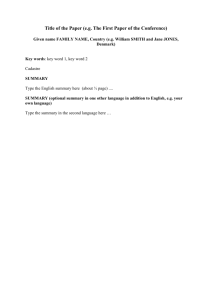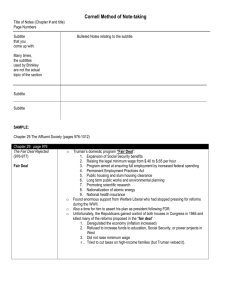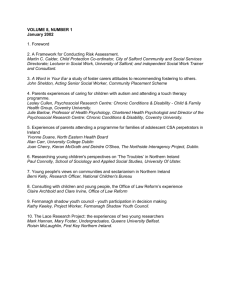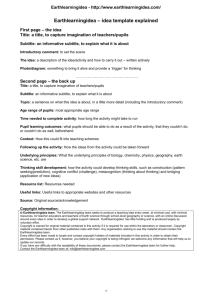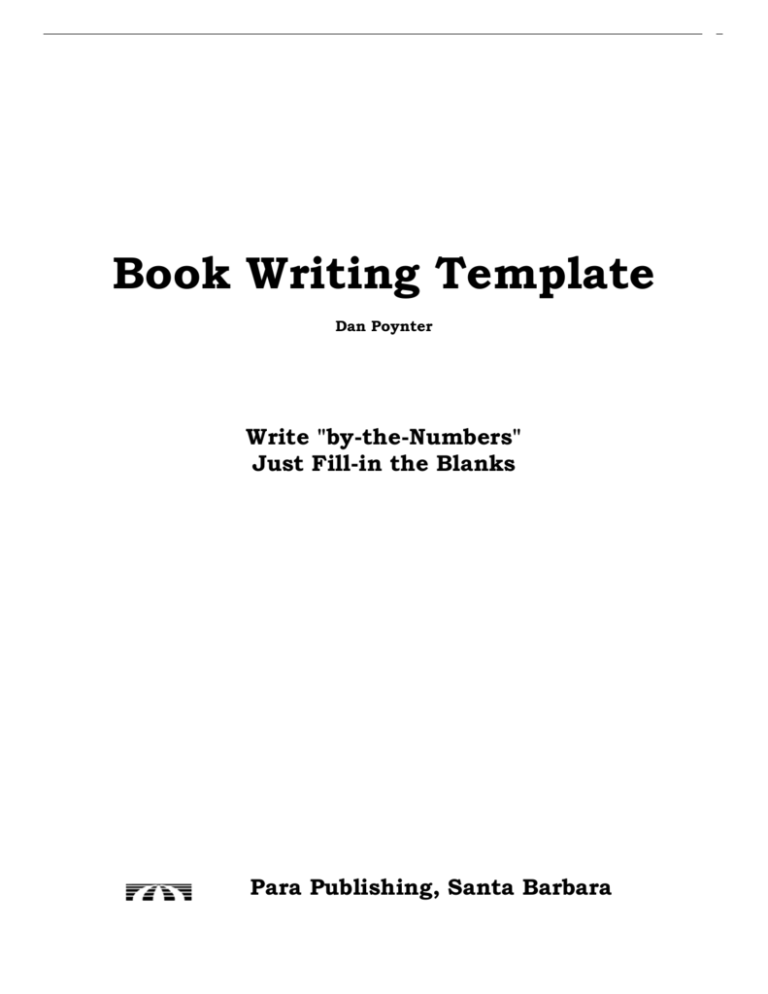
Book Writing Template
Dan Poynter
Write "by-the-Numbers"
Just Fill-in the Blanks
Para Publishing, Santa Barbara
Book Writing Template
Remove the staples from this Template and insert the pages into a 3-ring
binder. Separate the chapters, front matter and back matter with dividers. For
details, see pages 77-78 in Writing Nonfiction: Turning Thoughts into Books.
Build your book by filling in this template. You do not have to begin writing at
the beginning. Start by filling in any information you have at this time. Once
you have filled several pages, transfer the information to your computer. Then
print out the pages, 3-hole punch them and replace the old pages in the
binder.
This guide may be used for fiction but it is specifically designed for nonfiction
books.
Also see
Writing Your Book. Thinking/planning, writing and deciding on publishing:
Get an agent, find a publisher or publish yourself.
http://parapub.com/getpage.cfm?file=resource/writing.html
The New Book Model, Text.
http://parapub.com/getpage.cfm?file=newbook.html
The New Book Model, Audio.
http://www.jackstreet.com/jackstreet/RR.Newbookmodel.cfm
(Wait for the sound to load)
Does this system work? Thousands of published authors say YES!
See the Success Stories at
http://parapub.com/successstories.cfm?
© Copyright 2005, Dan Poynter
Para Publishing, Dan Poynter, PO Box 8206, Santa Barbara, CA 93118-8206, USA.
Tel: (805) 968-7277, Fax: (805) 968-1379, http://ParaPublishing.com
(Front Cover)
For a list of cover artists and URLs for examples of their work, see
http://parapub.com/supplier.cfm
Title:
Subtitle:
Author:
Foreword by:
.
(Testimonials)
Testimonials, endorsements and excerpts from reviews are being seen more and more on the first pages of
softcover books. This is important sales space. Put three testimonials on the back cover and the balance of
them here.
What others are saying about this book:
(Title Page)
The title page is on the right-hand side and lists the full title and subtitle of the book. This page may also
include the name of the author or editor, the publisher, whether this is an original or revised edition, location
of the publisher and the date.
Title:
Subtitle:
Author:
City and State of Publication:
(Copyright Page)
The copyright page or title page verso is on the reverse of the title page and is the most critical page in the
book. Proofread it a dozen times! Here you will print the copyright notice, show the printing history (number
of printings and revisions), list the LCCN, the ISBN, the Cataloging-in-Publication Data (CIP), name and
address of the publisher and printed in the United States of America or Printed in Canada (to avoid export
complications). For details and resources, get Document 112, Poynter's Secret List of Book Promotion Contacts
at
http://parapub.com/getpage.cfm?file=products.html
Those who know the book trade will often glance at the front and back cover and then turn to the copyright
page. The copyright page is important in selling a book to the trade, so make it look professional. You want to
appear to be a big-time publisher, not a kitchen-based word shop.
Each time you revise the book, it is worthwhile to change the copyright page in order to add, for example,
Second Printing, revised, 2005, as this lets the potential purchaser know the book is up to date. Most big
publishers do not make any changes to the copyright page and print a string of numbers on it instead. You
will note: “10 9 8 7 6 5 4 3 2 1,” which indicates to the trained eye that this is the first edition. Prior to
reprinting it, the printer will opaque out the “1” on the photographic negative.
Title:
Subtitle:
Author:
Published by:
(Your company name and address):
All rights reserved. No part of this book may be reproduced or transmitted in any form or by
any means, electronic or mechanical, including photocopying, recording or by any
information storage and retrieval system, without written permission from the author,
except for the inclusion of brief quotations in a review.
Copyright © 2005 by (Your name):
First Edition, 2005
Published in the United States of America
Or Canada, UK, Australia, etc.
(Dedication Page)
The dedication page. Some authors like to praise their family for supporting them during the book-writing
journey. This right-hand page was used historically by writers to acknowledge their patrons: the persons or
institutions that supported them financially while they wrote.
For
(Epigraph)
The epigraph page contains a pertinent quotation that sets the tone of the book. Using a separate page for an
epigraph is a nice touch
(Table of Contents)
The table of contents should start on the right-hand side. This page will include the chapter numbers,
chapter titles and beginning page numbers. You can leave the page numbers out for now. Fill them in later
when the book is formatted. Remember, when buying technical, professional or how-to books, some people
turn immediately to the table of contents to check the book’s coverage. Use some imagination when drafting
your chapter titles—make them descriptive and inviting. Your book may have any number of chapters. If you
plan on more than 12, just add pages.
Table of Contents
Chapter One
Chapter Two
Chapter Three
Chapter Four
Chapter Five
Chapter Six
Chapter Seven
Chapter Eight
Chapter Nine
Chapter Ten
Chapter Eleven
Chapter Twelve
(About the Author)
About the Author
Draft a page on yourself as it pertains to the subject matter in this book.
Photo of you
(Foreword)
Foreword
The foreword is positioned on the right-hand side and is a pitch for the book by someone other than the
author. Try to get an expert in your field to contribute a foreword. It is very prestigious when a person with a
recognizable name or a recognizable title is connected with your book. Contact one of your peer reviewers
about writing your foreword. Help this person by writing it yourself to demonstrate what you are looking for.
Experts are busy people, and it is always easier for them to edit than to create.
It is doubtful that many people read the foreword, but they will notice who wrote it. The fact is most readers
turn directly to the action. You may wish to note “Foreword by . . .” on the cover if that important name will
help sell books.
If you include a foreword, note the correct spelling; it is not “forward.” It is the “word” that comes before the
text.
(Acknowledgement)
Acknowledgement
Acknowledgments are a great sales tool. List everyone who helped you prepare your manuscript and book.
People love to see their name in print, and each will become a disciple spreading the word about your great
contribution to literature. On this blank sheet in your binder, add names of contributors as you encounter
them so none are left out.
I have not attempted to cite in the text all the authorities and sources consulted in the
preparation of this manual. To do so would require more space than is available. The list would
include departments of various governments, libraries, industrial institutions, periodicals and
many individuals.
Scores of people contributed to this book. Information and illustrations have been contributed by
(Disclaimer)
Disclaimers are showing up in more and more books today. Lawsuits are an unfortunate fact of life and while
disclaimers are not absolute protection against them, the warning can’t hurt.
Paraphrase this Disclaimer and do not leave the last sentence out. Judges have ruled you must provide
buyers with an alternative if they refuse to be bound by your disclaimer.
Warning—Disclaimer
This book is designed to provide information on writing, publishing, marketing, promoting and
distributing books. It is sold with the understanding that the publisher and author are not
engaged in rendering legal, accounting or other professional services. If legal or other expert
assistance is required, the services of a competent professional should be sought.
It is not the purpose of this manual to reprint all the information that is otherwise available
to authors and/or publishers, but instead to complement, amplify and supplement other texts.
You are urged to read all the available material, learn as much as possible about self-publishing,
and tailor the information to your individual needs. For more information, see the many
resources in appendix 2.
Self-publishing is not a get-rich-quick scheme. Anyone who decides to write and publish a
book must expect to invest a lot of time and effort into it. For many people, self-publishing is
more lucrative than selling manuscripts to another publisher, and many have built solid,
growing, rewarding businesses.
Every effort has been made to make this manual as complete and as accurate as possible.
However, there may be mistakes, both typographical and in content. Therefore, this text should
be used only as a general guide and not as the ultimate source of writing and publishing
information. Furthermore, this manual contains information on writing and publishing that is
current only up to the printing date.
The purpose of this manual is to educate and entertain. The author and Para Publishing shall
have neither liability nor responsibility to any person or entity with respect to any loss or
damage caused, or alleged to have been caused, directly or indirectly, by the information
contained in this book.
If you do not wish to be bound by the above, you may return this book to the publisher
for a full refund.
Chapter One
Title:
Chapter Two
Title:
Chapter Three
Title:
Chapter Four
Title:
Chapter Five
Title:
Chapter Six
Title:
Chapter Seven
Title:
Chapter Eight
Title:
Chapter Nine
Title:
Chapter Ten
Title:
Chapter Eleven
Title:
Chapter Twelve
Title:
(Appendix)
The appendix contains important lists and other resources; it may be composed of several sections. As you
collect information on your subject, add resources to this section. Add other books, reports, associations,
conferences, tapes, suppliers and so on. A book with a large appendix often becomes a valuable reference that
people have to own.
To save space, print just the company name and their URL. Area Codes and other address info change too
often. It is permissible to set this reference material in smaller type.
Appendix
Resources
(Glossary)
Glossary
The glossary is an alphabetically arranged dictionary of terms peculiar to the subject of the book. Some
authors like to save space and simplify use by combining the glossary and the index.
(Bibliography)
Bibliography
The bibliography lists the reference materials or sources used in writing the book.
(Index)
Index
The index aids the reader in locating specific information in the pages and is particularly important in
reference works. Many librarians will not purchase books without indexes, so plan on including an index. The
index is at the very end of the book to make it easy to locate.
Assembling the index is not hard if you build it with your word processing program. Simply read through your
typeset manuscript and list the key words and the page numbers. List all the main headings, subheadings
and words readers might look for. Double post two-word listings (“ripcord housing” and “housing, ripcord”),
and cross-reference different terms. Format the page in two columns, and set the type in ragged-right
alignment. Then use your computer to AutoSort the list.
The index must be revised every time the book is updated if the page numbers change.
(Order Blank)
Order blank. The last page of the book should contain an order blank; place it on a left-hand page—facing
out.
Some readers will want to purchase a copy of your book for a friend, while others may want a copy for
themselves after seeing your book at a friend’s home or in the library. Offer your other books and audios too.
Make ordering easy for them by listing the full price including sales tax (if applicable) and shipping cost.
Order blanks are easy and inexpensive—and they work.
QUICK ORDER FORM
Satisfaction guaranteed
email orders:
Fax orders: (
@
)
. Send this form.
Telephone orders: Call 1(
Have your credit card ready.
)
Postal orders:
Please send the following Books, Discs or Courses. I understand that I may
return any of them for a full refund—for any reason, no questions asked.
See our web site for FREE information on:
Other books, Speaking/Seminars, Mailing lists, Consulting.
Name:
Address:
City, State/Province, Postal Code
Tel:
Email:
Sales tax:
Shipping by air:
Payment: . Cheque,
Credit card:
. Visa, . MasterCard, . Optima, . AMEX, . Discover
Card number:
Name on card: Exp. date: /
http://www.ParaPublishing.com
Everyone Judges a Book by its Cover
And what you can do about it
L
ike it or not, no one reads the book before he or she makes a
buying decision. Consumers do not read it in the store. Sales reps
only carry book covers and jackets to show store buyers while
wholesalers and distributors say “just send us the cover copy.” All
buying decisions are made on the illustration/design and the sales
copy on the outside of the book. Yes, packaging is everything.
Each year, U.S. industry spends more than $50 billion on package
design. Now, that is not $50 billion for the packages and certainly not
for the contents. That money is for the design of the packages.
Packages prompt buyers to reach for the product whether it is
pantyhose, corn flakes or hair spray.
Stores have tens-of-thousands of books being displayed spine-out.
With all this congestion, it is hard to get attention. Initially, all a
potential buyer sees is the book’s spine. If the browser takes it down,
he or she will gaze at the cover about four seconds and the flip it over
to read the back cover. On average, he or she will spend just seven
seconds here so the trick is to keep them reading longer. Your copy has
to be punchy and benefit-laden; it has to speak to the potential buyer.
Your book cover designer will lay out the package and incorporate the
illustration, put it all on disk and send it to your printer but you must
draft the sales copy. This book cover worksheet will take you step-bystep through the sales-copy draft process. Use your computer so you
will be able to move the copy around once entered.
Here are explanations for each area of the outline.
A.
Front cover. Select a working title and subtitle. Keep the title
short and make the subtitle descriptive.
You will discover:
•
•
•
•
(benefit)
(benefit)
(benefit)
(benefit)
5. Testimonials and endorsements. Dream up three different
endorsements from people you would like to quote. If This book
changed my diplomatic strategy.—Colin Powell, would look good, try
it. Use names or titles recognizable in your field—sources that
might impress potential buyers. This is just a draft; dress it up. You
will secure some of these quotations later.
6. Show the author is the ultimate authority on the subject. Just
two or three sentences will do.
7. End with a sales closer in bold type. Ask the book-browser to
buy the book. Use something like This book has enabled thousands
to . . . and it will show you the way too.
8. Price. Bookstores like a price on the book. The price is a turn-off
to potential buyers so place it at the end of the sales copy. Never
locate the price at the top of the back cover. If this is a hardcover
book, place the price at the top of the front flap.
9. Bar code with International Standard Book Number (ISBN). The
bar code on a book identifies the ISBN, which in turn identifies the
publisher, title, author and edition (hardcover, etc.). Make room for,
but do not worry about, the bar code and ISBN just now.
List the most important person in your field (association or industry)
for the foreword (and please note the spelling of Foreword.) You will try Your title, subtitle, back-cover headline and benefits may be
swapped. Once you have them written down, you may wish to move
to get them to pen the foreword later.
some of them around. Perhaps one of your benefits would be a better
B. Spine. Stack the title on the spine so it will read more easily on the subtitle.
shelf. Use a bold, san-serif, vertically-legged typeface such as Arial
Most back cover copy is weak and uninspiring. The title is repeated and
Black, bolded.
then is followed by several quotations and a bar code and that’s it!
Haphazard copy is the sign of lazy (and maybe inexperienced)
C. Back cover.
copywriter. This lack of effective competition on the shelf gives us the
1. Category. Visit a bookstore and check the shelf where your book upper hand.
will be displayed. Note the categories on the books and the shelves.
Listing the category on the back cover of your book will insure your Book cover illustrations and design have improved tremendously over
book will be easy to find—because the bookshop personnel will the past 15 years. Author/publishers used to spend all their efforts on
the text and the cover became an afterthought. Some publishers
place it on the right shelf.
remember it was Robert Howard who brought bright, insightful,
2. Now you need an arresting headline addressed to potential relevant, remarkable covers to the industry. There are many great cover
buyers. You want them to relate to the book and find themselves in designers today and it was Robert Howard who started it all.
it. Do not repeat the title here; do not bore the potential buyer. You
have already “said it” on the front. Use an alternate approach. For A good cover artist will read through your book and create a cover that
example, The Self-Publishing Manual’s back-cover headline is Why will reflect the message of the text. The cover and text should match.
Not Publish Yourself?
Years ago, we said “Write your ad before you write your book.” This was
3. Sales copy. Concisely (two to four sentences) state what the to help you focus on who you were writing to and what you were going
to give them. Then we realized the most important ad you will ever
book is about. What will the reader gain by reading this book?
write is your back cover copy. Now we say: “Write your cover copy
4. Bulleted promises or benefits. Promise to make readers better before you write your book.”
at what they do. Pledge health, wealth, entertainment or a better
life. Focus on who your audience is and what they want. Think: Packages sell products and covers sell books. Give your books the
about who are you talking to and what are they going to get from opportunity in the marketplace they deserve. Package your text to
quickly tell the idle browser what is inside.
the book.
Editor’s note: Dan Poynter is the author of 29 books (and 85 revised editions). He is best known for The Self-Publishing Manual (14 revised
editions in 25 years). In the back of that book, he asks readers to send their book once published; he receives 10 to 15 books each week! He says
that cover art is improving but the sales copy still needs work on many of them. See http://ParaPub.com
-30-
(Back Cover)
Book Covers Work Sheet
Category:
(Spine)
Headline:
T
I
T
L
E
Sales copy/description. What is the book about?:
Promises & Benefits
You will discover:
•
•
•
•
(Front Cover)
Title:
Subtitle:
of
•
Testimonials:
1.
2.
3.
Why the author is qualified to write this book:
Closing copy:
B
O
O
K
Your last name
Price: $
(ISBN and bar code)
Author’s name:
Foreword by:
The New “Book” Model
Creating the Content
≡PDF ≡
A. Set up.
Idea for your book
Qualify project according to the Six Musts. WN-40
See Writing Nonfiction: Turning Thoughts into Books
Research the subject, title and competition.
Stores, Amazon, Ingram 615-213-6803
Get a Model Book.
Draft back cover sales copy. Doc 116, WN Ch 6.
Select a working title. Writing Nonfiction, Ch 5.
Set up the binder for the manuscript. WN Ch 7&8
Assemble research materials into chapter piles.
B. Build the content. WN, Ch 8.
1st draft. Assemble the elements
Write text in MS-Word in page-layout format.
Import digital photographs
Adobe PhotoDeluxe or PhotoShop or PhotoSuite
Import scanned drawings
Add art from Web
Producing the “Work”
≡
Publish: print & electronic versions. SPM Ch 11.
A. pBooks (Photos & Dwgs: 300 dpi TIF)
1. Press (ink on paper)
2. PQN (toner - digital.)
Need 300-500 to test the market & for reviews.
3. POD (one at a time)
B. eBooks (72 dpi. Photos: JPG; dwgs: GIF). Interactive
Downloadable
From your site
From other sites
Portable eBook readers. PDF and LIT files.
Also in Palm & MobiPocket
CDs & DVDs
------------------------------------------------------------------Media Asset Management
Multi-purpose your core content.
Wring maximum value out of your Work.
http://www.ClipArt.com
Find quotations on Web. See quotation sites.
Request stories from colleagues with email
Add URL hyperlinks to references
2nd draft. Content edit. Fill in the blanks.
3rd draft. Peer review for feedback. Use email.
Get testimonials for back cover, etc.
4th draft. Copy edit (punctuation, grammar).
Fact check
Proofread
A. Versions (downloadable) from your Web site
Audio version (Digital)
Special reports (spin off from book)
Articles (spin off from book)
Pricing pBooks & eBooks
B. Sell from Web site (not downloadable)
Seminars/Speeches
Record and sell the audio
Consulting
Expert witness testimony
Compatible (non-information) products
C. Convert to: (Writing Nonfiction, pgs 29-30).
1. PDF file with Adobe Acrobat
2. LIT file, MS-Reader with RosettaMachine.com
Help: http://parapublishing.com/supplier.cfm?
D. Get cover art
For more information, contact
DanPoynter@ParaPublishing.com; http://ParaPublishing.com
http://parapublishing.com/supplier.cfm?
Codes: WN: Writing Nonfiction; SPM: The Self-Publishing Manual
© Dan Poynter
Promoting the Editions
Make your company “Website-centric”.
Set up pressroom.
A. Book industry. Send sample books to:
Agents (if you wish to sell out)
Publishers (if you wish to sell out)
Distributor/bookstores/online bookstores
“Galleys” to pre-pub reviewers-SPM pg 176
Industry and early review copies. SPM Pg 179
Book clubs. See LMP & SPM, pg 269
Foreign rights-translations. See ILMP & SPM
B. Nontraditional markets. ID and Locate buyers.
Make Dealers (wholesale)
Specialty stores (think products not books).
Associations
Magazines
Events
Catalogs. SPM pg 297.
Premiums. SPM pg 262.
Fundraisers. SPM pg 265.
Military and government. SPM pg 262.
C. Disintermediation: sell directly to individual
reader/buyers (retail).
Promote your book with:
Review copies to magazines. SPM-185
Lists: http://parapublishing.com/getpage.cfm?file=/bookprom.html
News releases to magazines. SPM pg 204.
Services
http://www.book-publicity.com
eMail announcements (broadcast email)
eZine: Newsletter/List.
Business cards (no brochures)
Postcards (invite to Web site)
Online : email lists, chat rooms & news groups
Autographings/mini-seminars. See Doc 639
Posters & buttons
Radio and TV interviews. See Doc. 602



